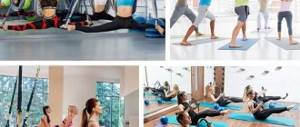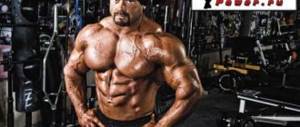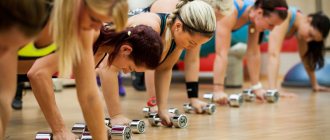© Drobot Dean - stock.adobe.com
Share:
What you need
- Barbell
- Dumbbells
- Horizontal bar
- Exercise equipment
When considering CrossFit and other areas of modern fitness, one cannot help but touch on the topic of circuit training, which is basic for many sports. What is it and how does it help beginners and professional athletes? Let's look further.
General information
Circuit training has been widely used almost from the very beginning of non-core sports disciplines. However, it received systematic justification with the development of weightlifting areas of fitness.
In particular, Joe Weider is considered one of the key figures in the development of circuit training, who created his split system as a contrast to unsystematized training. However, through opposition, he also created a basic theoretical system for substantiating circuit training, the principles on which it is based today.
Circular training for all muscle groups, according to Weider's definition, is a high-intensity training method that should involve all muscle groups and become maximum stress for the athlete's body, which will stimulate his body to further transformations.
Principles
Circular training for all muscle groups implies compliance with certain principles that distinguish it from other types of training:
- Maximum stress load. Maximum stress – stimulates the body to more intensive recovery, which allows you to achieve certain results much faster. However, at the initial stage, you should not perform every exercise to failure.
- High intensity training. Allows you to develop not only muscle strength, but also related energy systems (for example, the functioning of the cardiovascular system). There is no break between exercises in the circle or minimal – 20-30 seconds. Rest 1.5-2 minutes between circles. Number of circles – 2-6.
- Short duration. The short training time makes it accessible to most athletes. As a rule, such an activity takes 30-60 minutes (depending on the number of laps).
- Availability of strict specialization. The principles of developing circular training only imply a load on all muscle groups. The type of load determines the specialization factor of the main sport.
- Work your entire body in one workout. Typically, one exercise is allocated for each muscle group. At the same time, the order in which they are worked out changes from training to training. For example, on the first day you start with an exercise on the chest, on the second day - on the back, and so on.
- The intensity of the load on different muscle groups is determined by their size and susceptibility to loads. Basic exercises should be used primarily.
In bodybuilding and fitness, circuit training is used by beginners who find it difficult to immediately perform heavy multi-joint exercises with free weights, and during the drying phase. Gaining mass based solely on circuit training will not be effective. At this stage, the use of such a system is advisable only within the framework of load periodization.
An ideal body and maintaining muscle tone are the essence of the circuit training method
The circuit training technique consists of performing several types of exercises in turn.
They are done non-stop, with short pauses between each exercise and a long interval between each circuit.
What is circuit training?
Circuit training is a set of sports exercises.
During training, a person uses all or only certain muscle groups. During one lesson, from 6 to 10 different exercises are performed.
If you need to work one muscle group, for example, buttocks and thighs, then the total list of exercises for 1 circle does not exceed 6 types of movements. It is important to include 1-2 exercises for other muscles, for example, 4 movements for the legs and 2 for the abs.
The cycle needs to be diluted to reduce the long-term load and provide the muscles with a break, but without losing momentum.
The idea of circuit training is that a person completes a full workout in a short period of time. Here, the obligatory criterion is the non-use of heavy weights, and the intensity of the training - repetition of sets in turn. The selected list of exercises is done in a circle. The end of one circle is after performing all movements in a row.
Reference! One circle includes short pauses of up to 15 seconds. This interval is enough to calm your breathing a little and take the position for the next movement.
The break between cycles is:
Each task is performed at least 10 times. Depending on the level of difficulty, the number of repetitions varies from 10 to 30 times.
Objectives in physical education
The primary mission of the circuit training method in physical education lessons is to ensure the development of motor skills in a limited period of time. This is directly related to mastering the program.
Complexes of circuit training include exercises that are close in structure to the physical level of a specific group of trainees. Due to this, students favorably tolerate active actions while improving their development.
Circuit training as an integral form of physical education:
- strengthens thinking and attentiveness;
- develops a movement algorithm;
- develops organization and composure;
- improves physical condition.
Varieties
Like CrossFit, circuit training is only a method of building training that does not determine the further profiling of the athlete. The foundation laid in the basic principles of such training allows you to create variability in accordance with the needs of the athlete: starting from classical training, which is used in all areas associated with weightlifting (bodybuilding, powerlifting, etc.), and ending with combined athletics training with emphasis for the development of functional capabilities (Tabata, crossfit, etc.).
Let's take a closer look at the main options for circuit training in the table:
| Type of training | Peculiarity | Method of implementation |
| Basic circular | Maximum development of strength indicators by eliminating non-core exercises. | Only basic multi-joint exercises are used. |
| Bodybuilding circular | Maximum harmonious development of the body. Use by beginners as a foundation preparation for the transition to split and by more experienced athletes for drying. | Unlike the basic circular exercise, isolation exercises can be added if necessary. Cardio may be added during the drying phase. |
| Circular in Crossfit | Maximum development of functional strength due to the specifics of performing exercises. | Combining the principles of weightlifting and athletics involves developing functional strength and endurance. |
| Athletics | Maximum development of speed indicators. | Training involves the basic development of all muscle groups with the creation of adjustments for specialization. |
| Tabata Protocol | Maximum intensity combined with minimal training time. | The principle of continuity of training and the creation of suitable intensity is observed through the formation of strict time control in conjunction with monitoring the pulse. |
You need to understand that these types are presented solely as an example, since absolutely any type of training can be built on the principles of basic circuit training. For example, workout or boxer training, each of which has a combined nature and allows you to combine the principles of Tabata and athletics, or powerlifting and CrossFit.
Who is it suitable for?
Not every athlete can use circuit training to correct their body. This is not due to the genetic characteristics of the body. This fitness practice is not effective for those who exercise regularly. It will suit the following categories:
- For beginners. If you come to the gym for the first time, circuit training is the best way to get rid of extra pounds. The body of beginners is not yet ready for exercises that are aimed at working a specific muscle group. Accordingly, the brain uses neural connections to activate different muscles to work. Also, inexperienced athletes do not know the nuances of the technique of performing exercises. In this case, circuit training is the initial stage on the path to building a beautiful body. It is easy to learn and provides results almost immediately.
- Athletes after a long break. You can be an experienced trainee who knows the technique of performing complex exercises, but after a long “rest” the muscles atrophy - progress rolls back. Five days without physical activity are enough for the muscle fibers to spend part of their working potential and weaken. Enters the usual active mode, preferably with intense circuit training. Heavier loads after a break are dangerous to health.
- If you don't have enough free time to train. When it is not possible to visit the gym more than 1-2 times, heavy physical activity is contraindicated. If you're short on time, circuit training is best. It takes no more than 30-40 minutes.
- Beginners and experienced athletes during the drying period. When preparing for competitions or simply to quickly burn fat, many people resort to circuit training. Intense physical activity allows you to achieve excellent results without losing muscle mass.
Specialization in the long term
Considering the exercises for circuit training and the principle of its construction, it can be noted that it is never used throughout the year by athletes. It makes sense for beginners to practice this system for 2-4 months. Experienced cutting athletes can use circuit training for 2-3 months. At the recruiting stage, it would be rational to do one week of circuit training every 4-6 weeks as part of the periodization of loads.
Using circuit training all the time is ineffective, since the body gets used to this type of load, which reduces the effectiveness of the training.
Always running program
For those who are looking for an ideal working program, we offer an example of circuit training that is suitable for experienced athletes and beginners with at least minimal experience working with iron:
| Monday | ||
| Bench press on an incline bench | 1x10-15 |
|
| One-arm dumbbell row | 1x10-15 | |
| Leg press in the simulator | 1x10-15 | |
| Lying leg curls in the simulator | 1x10-15 |
|
| Seated dumbbell press | 1x10-15 |
|
| Standing barbell curls | 1x10-15 |
|
| French bench press | 1x10-15 | |
| Wednesday | ||
| Wide grip pull-ups | 1x10-15 | |
| Dumbbell Bench Press | 1x10-15 | |
| Leg extensions in the simulator | 1x10-15 |
|
| Romanian barbell deadlift | 1x10-15 | |
| Wide grip barbell row | 1x10-15 |
|
| Dumbbell curls while sitting on an incline bench | 1x10-15 |
|
| Triceps extensions on the block | 1x10-15 |
|
| Friday | ||
| Squats with a barbell on your shoulders | 1x10-15 |
|
| Romanian deadlift with dumbbells | 1x10-15 | |
| Dips | 1x10-15 | |
| Bent-over barbell row | 1x10-15 |
|
| Close grip press | 1x10-15 | |
| Scott Bench Curls | 1x10-15 |
|
| Arnold Seated Press | 1x10-15 | |
In total, you need to perform 3-6 such circles, the first of which is a warm-up. Rest between exercises – 20-30 seconds, between circles – 2-3 minutes. In the future, you can increase the intensity of the workout by increasing the number of circles, working weights and reducing rest time. In total, the program involves its implementation for 2-3 months, after which it is better to switch to a classic split.
Note: the division by day of the week remains conditional and implies adjustment to your own training schedule. There is no need to exercise according to this scheme more than 3 times a week.
The main advantages of this approach to training include:
- Lack of specialization for certain muscle groups. This allows you to prepare the athlete’s body for loads in any specialization in the future.
- Versatility. The weight on the equipment is determined by the athlete’s preparedness.
- Short training time. Unlike other sports, canonical circuit training can be done in 30-60 minutes.
- The ability to create adjustments and replace exercises with analogues in accordance with individual preferences.
Training programs
Use the suggested options as a guide.
In the gym
Example of a circle lesson:
- Pull-ups. We grab the horizontal bar with an overhand grip and perform 10 pull-ups, then change the grip to the opposite one and do 10 more pull-ups.
- Medicine ball push-ups. We take the position while lying down, placing our right palm on the medicine ball. We lower the body, then raise and change the position of the hands: the right one is on the floor, the left one is on the ball. We do push-ups from this position.
- Side jumps. We stand sideways to a horizontal bench. We push off with our feet and jump over it. We immediately perform a reverse jump.
- Bench press. We lie with our backs on the bench, placing our feet firmly on the floor. We grab the bar with a medium grip and perform vigorous chest presses. Avoid “beating” in the lower position. We select the warm-up weight in order to fully complete the approach.
- Kettlebell lifts. We stand up straight, spread our legs wide. We take one weight in our hands and hold it at groin level. Inhale, sit up on your feet a little and lift the weight above your head with a swinging motion. We don't bend our arms. As you inhale, straighten your legs and lower the weight.
- Burpee. From a vertical position, we sharply squat down and press our palms to the floor next to our feet. We quickly “jump” back, thereby assuming a plank position. We do push-ups from the floor. We jerk our hips towards our stomach and jump up as high as possible. We lower ourselves and repeat all the movements.
- Squats with press. We stand up straight, take dumbbells in our hands and raise them to shoulder level. We squat deeply, stand up and press the weight overhead.
- "Transitions" on hand. We lower ourselves into a classic prone position. Place one elbow on the floor, then the other. We repeat in reverse order. We move energetically, without pauses. When performing, keep your lower back straight, avoid bending and sagging.
- Jumping onto a plyo box. Choose a high platform (60–70 cm). We perform energetic jumping.
- Abdominal hip raise. We approach the wall bars, press our backs against it and perform a hang on the crossbar. Without lifting your lower back from the apparatus, you simultaneously raise your hips until they are parallel to the floor. We don't bend our knees.
The duration of the exercises (except the first) is 20 seconds each. The pause between elements is 5–10 seconds. We repeat the circle at least three times. The break between circles is 4–5 minutes.
At home
Example training plan:
- Jumping from a deep squat. We stand up straight, sharply lower ourselves into a deep squat and with a powerful push we jump as high as possible. During the jump, we stretch our arms up.
- Deadlift with a kettlebell. If you don't have a weight, you can use a backpack filled with books. We spread our feet slightly wider than our shoulders and take the load in our hands. We move our pelvis back and lean forward a little. The weight should drop to the floor. From the bottom point, we immediately begin to straighten our legs and straighten our body. When performing, keep your lower back arched.
- Jumping lunges. We get into a right lunge. Using a jerking motion, we jump up low and change the position of our legs in the air. We land in a left lunge.
- Push ups. We take a lying position and spread our arms wide. We do push-ups vigorously. When doing this, keep your body straight and don’t lower your head.
- Jumping in place. We stand up straight, push off with our feet and pull our knees up. We jump energetically, without pauses.
- Reverse push-ups. We turn our backs to two chairs, lower ourselves and press our palms against them. We stretch our legs in front of us, bringing our feet together. We perform push-ups from this position.
- Press raises. We lie down on the floor, bend our knees, and fix our feet under the sofa or chair. We cross our hands at the back of our heads. We perform body lifts to the knees.
- Plank jumps. We get into a plank position. With a jumping movement, we sharply pull both knees towards us. With a reverse jump, we “throw” our hips back.
- Push-ups with arm raises. We lower ourselves into a lying position. Keeping your back straight, push up from the floor. In the upper phase, we extend our arm in front of us. The next time we lift, we extend the other arm.
- Side twists. Lie on your back, bend your legs and place your feet on the floor. We place our palms on the back of our heads. As you exhale, twist to the right and pull your left elbow to the side. Then repeat the twist in the other direction.
The duration of each exercise is half a minute, pauses are 10–15 seconds. We perform 3-4 circular cycles. The break between laps is 3 minutes.
Circular vs crossfit
CrossFit, as a fitness discipline, grew out of the principles of circuit training with a subsequent emphasis on developing functional strength. Despite the large number of athletics, gymnastics and coordination exercises in the Crossfit Games competition program, it can be noted that prize-winning places are always taken by athletes with a core specialization in heavy exercises.
Let's consider whether CrossFit is a logical continuation of the principles of constructing circuit training, whether it includes them or completely opposes them:
| Circuit training | Canonical crossfit |
| The presence of constant progression. | Lack of profiling progression. The load is determined by Wod. |
| Progression is determined by working weight, number of repetitions, circles, rest time. | Likewise. |
| Using the same exercises over a 1-2 month cycle to optimize results. | Greater variety, allowing you to develop a profiling load by constantly shocking all muscle groups. |
| Possibility to vary exercises to suit specific requirements. | Likewise. |
| Extremely short training time. | The variability of training time allows you to develop different energy systems in the body, maximizing the amount of glycogen and oxygen susceptibility of the muscles. |
| The absence of strict specialization allows you to perform all tasks. Including developing strength, endurance, burning fat, improving heart function. The only limitation is that the suitability of the program is determined by the training period. | A complete lack of specialization, which allows for the development of the functional capabilities of the body. |
| Suitable for athletes of any level of fitness. | Likewise. |
| A trainer is required to monitor the results and technique of performing the exercises. | Likewise. |
| A heart rate monitor is needed to prevent athlete's heart syndrome. | Likewise. |
| A relatively safe training method. | A rather traumatic sport that requires greater control over technique, heart rate and execution time in order to minimize risks to the body. |
| There is no need to train in a group. | The greatest effectiveness is achieved in group training. |
Based on all of the above, we can conclude that CrossFit combines the principles of circuit training, organically processing them in conjunction with other basic principles of fitness to achieve optimal results.
Circuit training is perfect as a pre-training for CrossFit classes or fits seamlessly into one of the WOD programs performed during the week.
What is circuit training?
Many people do not take circuit training seriously, considering it entertainment for girls. Hundreds of articles have been written stating that it is impossible to build muscle in this way. Of course, if you constantly just squat and do light jumps, there will be no result - you end up with regular cardio.
However, by adding various weights to the training process, you can achieve great results as a result of regular exercise. So what is true circuit training? This is a set of exercises for all muscle groups that are repeated for several cycles or circles in an intensive mode. The program provides for rest, but it is minimal.










